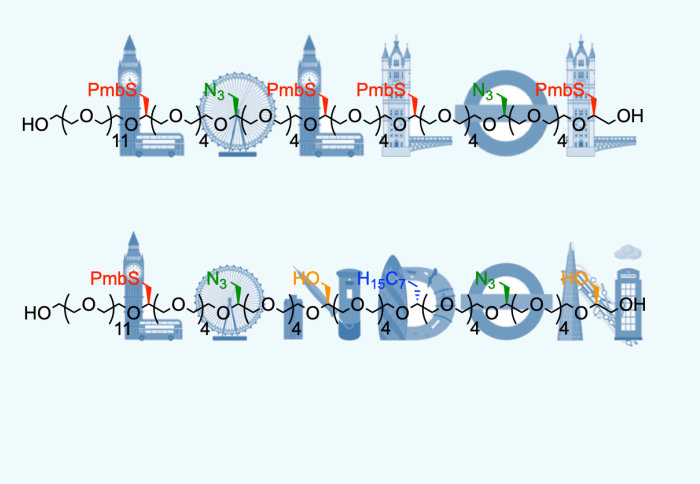
Researchers adapted the polymer sequence to spell 'LOLLOL' and 'LONDON'

Researchers at Imperial College London have developed a new class of multi-functional sequence-defined polymers.
A team of chemical engineers and chemists in the Livingston Group have used liquid-phase synthesis coupled to molecular sieving to create a polymer of extraordinary molecular precision which could open up new possibilities in drug delivery, nanotechnology, and information storage.
Published today in Nature Chemistry, this paper details a new method of synthesis known as Nanostar Sieving, which allows the researchers to have complete control over the sequence of monomers which make up the resulting polyether (polyethylene glycol, or PEG). This enables specific functions, such as the delivery of anti-cancer drugs to specific tumor sites in the human body, and the storage of information in the monomer order.
Sequences in nature
Biopolymers are composed of thousands of molecules or more that occur naturally in the human body; the most familiar of these is DNA. Nature is able to create these uniform sequence structures with a high level of precision, and they provide structural and functional diversity which is sufficient to perform a range of functions within the body. Proteins, as an example, are long chains of amino acids which are responsible for several functions such as growth and the production of antibodies.
It’s an exciting piece of research because we’re one step closer to creating a well-defined hierarchical structure which mimics that found in nature. Dr Ruijao Dong Research Associate, Department of Chemical Engineering
Chemists have developed synthetic polymers that work by mimicking these natural sequences to deliver additional functions. Polyethers are favoured by doctors and surgeons because of their excellent water solubility and biocompatibility, making them perfect for use in medicines and surgery. However traditional methods have resulted in polymers which lack the same level of precision found in nature, due to the limited control scientists have over the production process.
Polymer PEGabet
Polymers can be understood as words, and monomers as the letters which make words. Regular synthetic polymers have only one ‘letter’, but can be ‘words’ of varying length, for example ‘LL’, ‘LLL’ or ‘LLLL’. Sometimes additional letters are used such as LLO or OLL, but chemists have only loose control over the order and number of the letters.
Using Nanostar Sieving, the team at Imperial has been able to exert exact control over the sequence of ‘letters’ and have used 4 different PEG monomers to spell LOLLOL and LONDON, in a polymer alphabet or PEGabet. This full control over the final polymer structure opens the way to range of applications in drug delivery, nanotechnology and even information storage.
Next steps
Dr Ruijiao Dong, lead researcher on the project, said: “It’s an exciting piece of research because we’re one step closer to creating a well-defined hierarchical structure which mimics that found in nature. By developing a universal strategy for precisely controlling sequence in polymers we’re in theory able to do many things, as the sequence plays a crucial role in information storage and function expression, offering potential for a wide range of applications. We are excited to test the limits of its functionality with further research, and to further develop and automate the Nanostar Sieving.”
The team will now explore the practical application of this new polyether and experiment with further polymers, with the goal of producing a biodegradable version, and controlling 3D structure of the final polymers, as well as developing read/write methods for information storage and automating the polymer synthesis.
Read the paper in full at Nature Chemistry.
Read more about this research on our blog.
Article text (excluding photos or graphics) © Imperial College London.
Photos and graphics subject to third party copyright used with permission or © Imperial College London.
Reporter

Sara West
Communications Division



